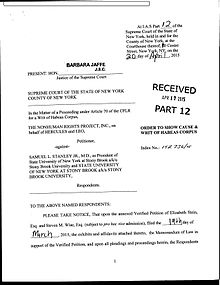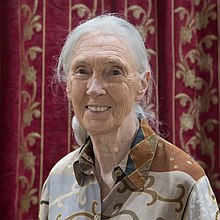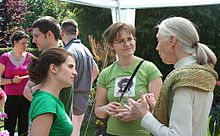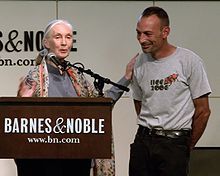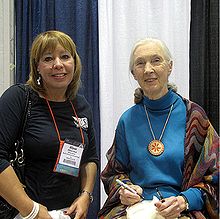From Wikipedia, the free encyclopedia
Nonhuman Rights Project
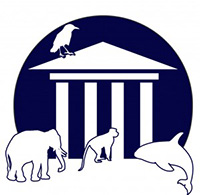 |
| Founded | 2007 (as a project of the Center for the Expansion of Fundamental Rights), officially renamed NhRP 2012 |
|---|
| Founder | Steven Wise |
|---|
| Type | 501(c)(3) |
|---|
| Focus | Animal rights |
|---|
| Location |
|
|---|
Area served
| United States |
|---|
| Method | Sustained strategic litigation |
|---|
Key people
| Steven M. Wise, Jane Goodall, Kevin Schneider, Elizabeth Stein, Monica Miller, Michael Mountain |
|---|
| Website | www.nonhumanrightsproject.org |
|---|
The
Nonhuman Rights Project (
NhRP) is an American
animal rights nonprofit organization seeking to change the legal status of at least some
nonhuman animals from that of
property to that of
persons, with a goal of securing rights to bodily liberty (the right not to be imprisoned) and
bodily integrity (the right not to be experimented on). The NhRP works largely through state-by-state litigation in what it determines to be the most appropriate
common law jurisdictions and bases its arguments on existing scientific evidence concerning
self-awareness and
autonomy
in nonhuman animals. Its sustained strategic litigation campaign has
been developed primarily by a team of attorneys, legal experts, and
volunteer law students who have conducted extensive research into
relevant legal precedents. The NhRP filed its first lawsuits in December 2013 on behalf of four
chimpanzees held in captivity in New York State. In late 2014, NhRP President
Steven Wise and Executive Director Natalie Prosin announced in the
Global Journal of Animal Law
that the Nonhuman Rights Project was expanding its work into other
countries, beginning in Switzerland, Argentina, England, Spain,
Portugal, and Australia.
The Nonhuman Rights Project is currently one of Animal Charity Evaluators' Standout Charities.
History
Founded by attorney
Steven M. Wise, the Nonhuman Rights Project began in 2007 as a project of the Center for the Expansion of Fundamental Rights. In 2012, the Center for the Expansion of Fundamental Rights officially changed its name to the Nonhuman Rights Project.
Mission and goals
According
to the NhRP's website, the mission of the Nonhuman Rights Project is,
through education and litigation, to change the common law status of at
least some nonhuman animals from mere "things," which lack the capacity
to possess any legal right, to "persons," who possess such fundamental
rights as bodily integrity and bodily liberty and those other legal
rights to which evolving standards of morality, scientific discovery,
and human experience entitle them. To advance this mission, the NhRP's
specific goals are:
- To persuade a United States state high court to declare that a
specific nonhuman animal is a legal person who possesses the capacity
for a specific legal right.
- To persuade US state high courts to increase the number of
legal rights of any nonhuman animal who is declared to be a legal person
to the degree to which it should be entitled.
- To persuade US state high courts to declare that appropriate
nonhuman animals possess the capacities for legal rights and to extend
legal rights to them accordingly.
- To educate the legal profession and judiciary about the legal,
social, historical and political justice of the Nonhuman Rights
Project's arguments.
- To communicate to the public and media the NhRP's mission and
the justice of recognizing specific nonhuman animals as legal persons.
- To educate the courts, the legal profession, the media, and
the public about the state of current knowledge about the cognition of
those nonhuman animals who are, or who might be, plaintiffs in the
Nonhuman Rights Project's lawsuits.
Legal claims
The NhRP argues that nonhuman animals who are scientifically proven to be self-aware, autonomous beings, such as
great apes,
elephants,
dolphins, and
whales, should be recognized as legal persons under U.S. common law, with the fundamental right to bodily liberty.
According to the NhRP, there is nothing in the common law that suggests
that legal personhood is limited only to human beings, and certain
species fit the profile that courts have used in the past to recognize
legal personhood. The NhRP emphasizes the fact that currently all
nonhuman animals are considered merely property, or legal "things,"
without the capacity for rights. In an article published five months before the NhRP first filed suit, Chris Berdick of
Boston Globe explains the organization's claims and strategy as follows:
Armed with affidavits from
scientists, including Jane Goodall, about chimps' capacities, [the NhRP]
will argue that their plaintiff deserves a right to liberty, and that
its captivity is a violation of that right. Win or lose, they plan to
bring more habeas petitions on behalf of other animals, hoping to win
enough small victories to lay a foundation of precedent for animal
personhood. It's unlikely to be a quick and easy fight, but Wise says he
accepts that he's in the animal-personhood game for the long haul.
"This is a long-term, strategic, open-ended campaign," he says.
Somerset v. Stewart
The NhRP's legal claims on behalf of captive nonhuman animals are based in part on the case of
Somerset v Stewart. In that 1772 case,
William Murray, 1st Earl of Mansfield, the chief justice of the English Court of King's Bench, issued a writ of habeas corpus on behalf of a slave named
James Somerset;
Somerset was subsequently freed. NhRP argues that it was the first time
a human slave was considered to be a person and who was allowed to
petition for and be granted the writ for habeas corpus.
The decision was made even though there was no precedent that it relied
on. The NhRP views the writ of habeas corpus as a powerful form of
redress for the denial of their plaintiffs' right to bodily liberty.
Commenting on the importance of the Somerset case to the NhRP in a 2014
article by
Charles Siebert in
The New York Times Magazine, Wise said:
A legal person is not synonymous
with a human being. A legal person is an entity that the legal system
considers important enough so that it is visible and [has] interests
[and] certain kinds of rights. I often ask my students: 'You tell me,
why should a human have fundamental rights?' There's not a single person
on earth I've ever put that question to who can answer that without
referring to certain qualities that a human has.
Opposition and counterarguments
Some legal scholars have publicly opposed the NhRP's mission and goals. Federal appeals judge
Richard Posner,
for example, is opposed to legal personhood for nonhuman animals on the
basis that the law grants humans special status not because of their
intelligence but out of "a moral intuition deeper than any reason that
could be given for it and impervious to any reason that you or anyone
could give against it." Attorney and Pepperdine Professor of Law Richard Cupp has argued that
animal welfare
laws should be sufficient for ensuring the well-being of captive
nonhuman animals and that the NhRP's strategy is unnecessarily extreme.
In an interview with the James Gorman of
The New York Times
following the organization's first lawsuits, Cupp said, "The courts
would have to dramatically expand existing common law for the cases to
succeed."
In response, the NhRP argues that an animal welfare approach is
insufficient and ineffective in terms of ending the practice of keeping
chimpanzees and other cognitively complex nonhuman animals in captivity
and also does nothing to address the larger issue of their status as
legal property.
Court cases
Tommy, Kiko, and Hercules and Leo
The
NhRP filed its first lawsuits on December 2, 2013, in New York State on
behalf of four captive chimpanzees, demanding that the courts grant
them the right to bodily liberty via the writ of habeas corpus and to
immediately send them to a sanctuary affiliated with the North American
Primate Sanctuary Alliance.
The NhRP's New York plaintiffs were Tommy, a privately owned
chimpanzee living in a cage in a shed on a used trailer lot in
Gloversville, NY; Kiko, a privately owned chimpanzee living on private
property in Niagara Falls, NY; and Hercules and Leo, two chimpanzees
owned by New Iberia Research Center and loaned to the Anatomy Department
at Stony Brook University for use in locomotion research.
In response to the lawsuit, Tommy's owner, Patrick Lavery, defended the
chimpanzee's living conditions: "He's really got it good. He's got a
lot of enrichment. He's got color TV, cable and a stereo."
All of the petitions were rejected. On March 19, 2015 case of Hercules and Leo was refiled. And on April 20, 2015, Justice Barbra Jaffe issued an Order to Show Cause and Writ of Habeas Corpus.
A hearing was scheduled at which the State University of New York at
Stoney Brook was ordered to show why Hercules and Leo should be not be
released and transferred to the Save the Chimps sanctuary.
Because the order's title included the phrase "WRIT TO HABEAS CORPUS"
it made headlines around the world and was misinterpreted as granting
the right to liberty to a chimpanzee. Justice Jaffe's order was amended and refiled with the phrase WRIT OF HABEAS CORPUS manually crossed out. A hearing was held on May 27 and on July 29, 2015, Justice Jaffe issued an order denying Hercules and Leo's petition.
Because of the fact that the petition was reviewed as well as the
reasoning in the decision, NhRP considered it to be a "one giant leap
for the Nonhuman Rights Project in its fight for the fundamental rights
of nonhuman animals."
Petition for a Writ of Habeas Corpus
In filing the petitions NhRP's intent was:
- To have the chimpanzees recognized as human-like beings with a
common law right to liberty, specifically, to be recognized as
autonomous and self-determining beings that cannot be legally considered
as property. and
- To have the chimpanzees released and transferred to a North American Primate Sanctuary Alliance (NAPSA) sanctuary.
A
writ of habeas corpus
allows an individual to assert one's right to liberty and demand for
release from unlawful imprisonment. The right to file the writ is
protected in the US Constitution under Article 1, Section 9, and in New
York State it is to be filed under article 70 which states that "a
person
illegally imprisoned or otherwise restrained with his liberty within
the state ... may petition without notice for a writ of habeas corpus to
inquire into the cause of such detention and for deliverance." In order
for their petitions to be considered, NhRP had to first show that the
chimpanzees are persons who could file them.
NhRP's arguments were partially based on
precedent, a legal term that encompasses all previous legal decisions and reasoning also known as
common law. These cases can be considered to be relevant and sometimes decisive to the current facts and circumstances at hand. As its first step, NhRP argued that the legal term
person is
not a synonym for a human being, but instead refers to an entity with a
capacity to possess legal rights. It emphasized that there are no
necessary conditions for determining that an entity is a legal person,
and that going back to the 18th century there have been cases granting
legal rights to non human entities such as corporations. NhRP argued
that the fact that a chimpanzee is not a human being should not prevent
the argument that it is a legal person with a habeas corpus right to
liberty.
It then made its central point, that based on previous common law decisions such as
Somerset v Stewart,
autonomy and self-determination are the human qualities that are
intended to be protected by the writ of habeas corpus. And because
chimpanzees are now known to possesses the same qualities, the habeas
corpus right to liberty should be expanded to the chimpanzee species.
More than thirty pages of the petition were devoted to going over
chimpanzee evolutionary development, neurology, social practices and
complex cognition. NhRP argued that a chimpanzee possesses qualities
such as:
... the possession of an
autobiographical self, episodic memory, self-determination,
self-consciousness, self-knowing, self-agency, referential and
intentional communication, empathy, a working memory, language,
metacognition, numerosity, and material, social and symbolic culture,
their ability to plan, engage in mental time travel, intentional action,
sequential learning, mediational learning, mental state modeling,
visual perspective-taking, cross-modal perception, their ability to
understand cause-and-effect, the experiences of others, to imagine,
imitate, engage in deferred imitation, emulate, to innovate and to make
and use tools.
NhRP emphasized that it was not seeking a granting of human rights
for its plaintiffs but only a narrow expansion of the right to bodily
liberty protected by the writ of habeas corpus.
Initial holdings
All
three petitions where denied on the grounds that the chimpanzees were
not persons and thus the issues in the petitions would not be
considered. In an hour long hearing regarding Tommy's Third District case, the Hon. Joseph Sise stated that:
Your impassioned representations to
the Court are quite impressive. The Court will not entertain the
application, will not recognize a chimpanzee as a human or as a person
who can seek a writ of habeas corpus under Article 70. I will be
available as the judge for any other lawsuit to right any wrongs that
are done to this chimpanzee because I understand what you're saying. You
make a very strong argument. However, I do not agree with the argument
only insofar as Article 70 applies to chimpanzees. Good luck with your
venture. I'm sorry I can't sign the order, but I hope you continue. As
an animal lover, I appreciate your work.
The judge in Kiko's Fourth district case, the Hon. Ralph A. Boniello
III, also held a hearing, denying the NhRP's petition on the grounds
that Kiko is not a person for purposes of habeas corpus and stating that
he did not want to be the first "to make that leap of faith."
The judge in Hercules' and Leo's Second District case, the Hon. W.
Gerard Asher, did not hold a hearing, writing in a decision that he was
denying the petition for habeas corpus on the basis that chimpanzees are
not considered legal persons.
Appeals
Tommy's case
The NhRP appealed the lower court's decision in Tommy's case.
The appeal was granted and oral argument took place on October 8, 2014
before the Supreme Court, Appellate Division, Third Judicial Department
in Albany, NY. The hearing received significant media attention. On December 5, 2014, the appellate court issued its ruling. In
its decision the court confirmed the earlier ruling that there is no
precedent for finding that an animal could be thought of as a person. It
further reasoned that in accordance with the social contract one's
rights cannot come without obligations:
The lack of precedent for treating animals as persons for habeas corpus purposes
does not, however, end the inquiry, as the writ has over time gained
increasing use given its great flexibility and vague scope. While
petitioner proffers various justifications for affording chimpanzees,
such as Tommy, the liberty rights protected by such writ, the ascription
of rights has historically been connected with the imposition of
societal obligations and duties. Reciprocity between rights and
responsibilities stems from principles of social contract, which
inspired the ideals of freedom and democracy at the core of our system
of government. Under this view, society extends rights in exchange for
an express or implied agreement from its members to submit to social
responsibilities. In other words, rights are connected to moral agency
and the ability to accept societal responsibility in exchange for those
rights. ...
Needless to say, unlike human beings, chimpanzees cannot bear any
legal duties, submit to societal responsibilities or be held legally
accountable for their actions. In our view, it is this incapability to
bear any legal responsibilities and societal duties that renders it
inappropriate to confer upon chimpanzees the legal rights — such as the
fundamental right to liberty protected by the writ of habeas corpus — that have been afforded to human beings.
On December 18, 2014, the NhRP announced that it had filed a motion
for permission to appeal to New York's highest court, the Court of
Appeals.
Kiko's case
The NhRP also appealed the lower court's decision in Kiko's case.
Like Tommy's, Kiko's appeal was also granted and oral argument took
place on December 2, 2014 before the New York Supreme Court Appellate
Division, Fourth Department in Rochester, NY.
At Kiko's hearing the two main issues were: how could it be determined
that a chimpanzee actually wanted to be released, and could a transfer
to another location be considered as a release from confinement, the
purpose of the writ of habeas corpus.
NhRP argued that the issue of whether or not Kiko actually desired to
be released was regularly resolved in cases dealing with autonomous and
self-determining human beings who at that time are incompetent or are
too young to make those decisions. When asked which one of those grounds
is most similar to the circumstances of this petition, NhRP replied
that a chimpanzee is more akin to a child near the age of five rather
than a mentally disabled adult.
On January 2, 2015, the appellate court issued its decision,
denying the petition on the grounds that "habeas corpus does not lie
where a petitioner seeks only to change the conditions of confinement
rather than the confinement itself. We therefore conclude that habeas
corpus does not lie herein." Commenting on the Court's decision in a blog post on the NhRP's website, Wise wrote:
Yesterday the Fourth Department
ignored both the Second Department and the Third Department. It threw
out Kiko's case not because the NhRP had no right to appeal and,
significantly, not because Kiko could not be a "person." It was, the
court wrote, because not even a human being can use a writ of habeas
corpus to move from a place of stark imprisonment to another place of
vastly more freedom. (The NhRP is demanding that Kiko be moved from his
solitary caged confinement to the spacious sanctuary of Save the Chimps
in Fort Pierce, Florida, where he will live his life on a semi-tropical
island surrounded by dozens of other chimpanzees.) Every single one of
the eight cases cited by the Fourth Department concerns a human prisoner
convicted of a crime using a writ of habeas corpus for some other
purpose other than seeking immediate release from prison. The Fourth
Department's decision treats Kiko as if he were a human prisoner
convicted of a crime and ignores numerous cases spread over 200 years
involving humans who were NOT prisoners convicted of a crime
successfully using a writ of habeas corpus to move from one place to
another. The NhRP will therefore be asking the Fourth Department for
leave to file an appeal to the Court of Appeals within the next week. If
the Fourth Department says "no," we will ask the Court of Appeals
itself for leave to appeal.
On April 20, 2015, the NhRP filed a motion for permission to appeal in New York's highest court, the Court of Appeals.
Hercules and Leo Reconsidered
ORDER TO SHOW CAUSE & WRIT OF HABEAS CORPUS
NhRP also filed an appeal to Hercules and Leo's lower court decision.
On April 3, 2014 the appeal was denied by the Second Appellate
Department in Brooklyn, this dismissal was based on a technicality and
NhRP's briefs were not considered.
On March 19, 2015, NhRP was allowed to refile the petition at the
county court in Manhattan which is under the First Appellate Department. Justice Barbra Jaffe was assigned to the case.
On April 20, 2015, Justice Barbra Jaffe issued an Order To Show Cause & Writ of Habeas Corpus.
A hearing was scheduled at which the State University of New York at
Stoney Brook was ordered to show why Hercules and Leo should be not be
released and transferred to the Save the Chimps sanctuary.
Because this order was titled as ORDER TO SHOW CAUSE & WRIT OF
HABEAS CORPUS it immediately made the headlines around the world as
granting the right to liberty to the chimpanzees.
"Justice Recognizes Two Chimpanzees as Legal Persons, Grants them Writ
of Habeas Corpus" was the headline of NhRP's breaking news post on its
website.
Because of the global headlines, Justice Jaffe's order was amended and
refiled with the phrase WRIT OF HABEAS CORPUS manually crossed out.
It is likely that this was done to make it clear that the order was
granted only to allow a hearing for an evaluation of arguments made in
NhRP's petition.
The next day NhRP updated its posting stating that "the Order does not
necessarily mean that the Court has declared that the two chimpanzees,
Hercules and Leo, are legal persons for the purpose of an Article 70
common law writ of habeas corpus proceeding."
On May 27, a hearing was held for the purposes of the initial evaluation of Hercules and Leo's Petitions. Justice Jaffe's ruling was entered on July 29, 2015. In her ruling Justice Jaffe stated that in making her decision she was obliged to follow the ruling of a higher court.
Because of a conflict in relevant decisions of between the First
Department and the Fourth Department where Tommy's case was decided,
Justice Jaffe relied on the Third District's Tommy decision.
That appellate court ruled that a chimpanzee could not be considered a
person with the right to liberty because there is no precedent for such a
decision, and that rights cannot be granted without social
responsibilities. She further stated that even if she was not bound by
the Third Department decision in Tommy it should be up to the
legislature or higher courts given their role in setting government
policy.
Even though the petition was denied, NhRP interpreted Justice
Jaffe's decision as a victory. In his posting titled "That's One Small
Step for a Judge, One Giant Leap for the Nonhuman Rights Project", Mr.
Wise emphasized the fact that Justice Jaffe agreed with NhRP when
finding that "'persons' are not restricted to human beings, and that who
is a 'person' is not a question of biology, but of public policy and
principle." He finished by quoting the last paragraph of Justice Jaffe's decision:
Efforts to extend legal rights to
chimpanzees are thus understandable; some day they may even succeed.
Courts, however, are slow to embrace change, and occasionally seem
reluctant to engage in bolder, more inclusive interpretations of the
law, if only to the modest extent of affording them greater
consideration. As Justice Kennedy aptly observed in Lawrence v. Texas
(the 2003 gay rights case that struck down a state sodomy statute),
albeit in a different context, "times can blind us to certain truths and
later generations can see that laws once though necessary and proper in
fact serve only to oppress. The pace may be accelerating (citing the
recent gay marriage case "granting the right to marry to same sex
couples and acknowledging that institution of marriage has evolved over
time notwithstanding its ancient origin"). For now, however, given the
precedent to which I am bound, it is hereby ORDERED, that the petition
for a writ of habeas corpus is denied.
Despite the ruling in its favor, the university
released an official statement that it would no longer conduct
scientific studies on Hercules and Leo.
An appeal was filed in August 2015, however that December Stony Brook
transferred the chimpanzees back the New Iberia Research Center, ending
the case, since the New York State Court no longer had jurisdiction over
them.
On September 1, 2015, NhRP's requests to file appeals to the highest court in Tommy's and Kiko's cases were denied.
On December 2, 2015 NhRP refiled Tommy's petition in the First
Department in Manhattan, New York City, this is the same district as the
one where Justice Jaffe issued her ruling.
The NhRP and PETA's slavery lawsuit
In October 2011, People for the Ethical Treatment of Animals (
PETA) filed a complaint in a California federal district court alleging that
SeaWorld was enslaving its captive
orcas in violation of the orcas' rights under the
Thirteenth Amendment to the United States Constitution.
The NhRP, while acknowledging that the orcas might be considered slaves
according to common usage of the term, vehemently opposed the lawsuit
on the grounds that it was strategically misguided and
counter-productive; the NhRP's critique highlighted the existence of
differing strategies for achieving rights and protections for nonhuman
animals.
"The claim that an orca is enslaved within the meaning of the
Thirteenth Amendment is unlikely even to receive a single vote from a
federal appellate court in 2011," Wise wrote on the NhRP's website. "It
is unthinkable that the present United States Supreme Court would
agree." In January 2012, the presiding judge, the Hon. Richard Miller, granted permission to the NhRP to appear in the case as an
amicus curiae
(or Friend of the Court) to, as Wise said, "ensure that the orcas' best
interests are being properly represented, that their legal status is
advanced, and that an unfavorable ruling inflicts the least possible
harm on the development of an animal rights jurisprudence."
In February 2012, the case was dismissed. The judge wrote in his
ruling that "the only reasonable interpretation of the Thirteenth
Amendment's plain language is that it applies to persons, and not to
non-persons such as orcas." In an interview with the blog Earth in Transition, Wise said of the ruling
Sometimes it's better to do nothing
than to do something harmful. The problem with the PETA suit is that it
was doomed from the beginning, and we in the Nonhuman Rights Project
immediately recognized that. When you study legal process you learn that
the first cases in a new area often tend to take on an unusual level of
importance. When you litigate in a novel area, you want to begin with
your strongest suits in the most favorable jurisdictions. The rule for
the Nonhuman Rights Project is: Win big and, if we must lose, lose
small. PETA had virtually no chance of even winning small and a
tremendous chance of losing big.
Documentary
Documentary filmmakers
D.A. Pennebaker and
Chris Hegedus announced in July 2012 that their next project,
Unlocking the Cage, would follow the NhRP's efforts to achieve legal rights for nonhuman animals. In April 2014, Pennebaker-Hegedus Films released a preview of the as-yet-unfinished documentary in the form of a
New York Times Op-Doc called
Animals Are Persons Too.
Unlocking the Cage was released in 2016.
Animal Charity Evaluators review
Animal Charity Evaluators (ACE) named NhRP one of its Standout Charities in its 2015 and 2016 annual charity recommendations.
ACE designates as Standout Charities those organizations which they do
not feel are as strong as their Top Charities, but which excel in at
least one way and are exceptionally strong compared to animal charities
in general.
Among the NhRP's strengths, according to ACE, is the fact that it
is the only organization they know of directly working towards legal
personhood for animals, which "could be the most promising avenue for
the proper consideration of nonhuman animals in our society." The NhRP
has also garnered public attention with their cases, which has plausibly
helped the animal advocacy cause. ACE states as a weakness NhRP's
focus on certain cognitively complex animals, and uncertainty about
whether the NhRP's activities will eventually expand to larger groups of
animals.








